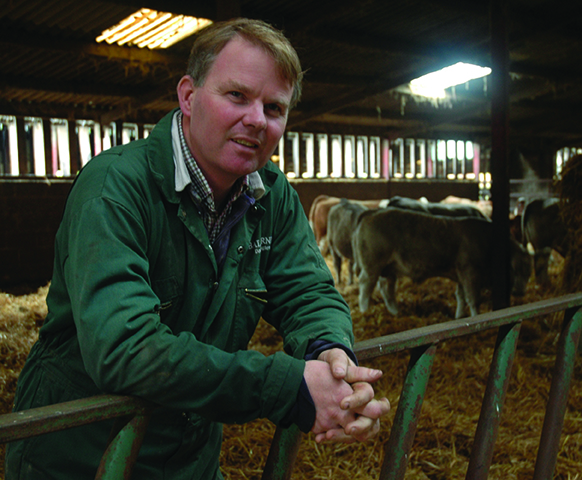Focus on Eye Muscle Area and Retail Beef Yield EBV selection
VIA (Video Image Analysis) is an automated method of objectively assessing visual carcase conformation and fat classes to comply with EU regulations on carcase classification. The new technology removes the subjectivity which allegedly accompanies the current manual grading system, between lines and between slaughter houses. What’s more VIA is able to improve the precision and accuracy of saleable meat yield, even for specific carcase joints.
VIA has already been officially introduced to slaughter houses in Ireland, both the north and south. The mechanism has also been installed for trial purposes in Scottish plants. It’s a question of time when VIA will be introduced on a commercial basis throughout Great Britain, and whether or not an accompanying new pricing system will be introduced.
Commercial producers are already starting to gear up for VIA to replace manual grading in Scotland. Balbirnie Home Farm’s David Aglen says: “By the time the new technology is officially introduced, I want a shed of animals ready finished that will be able to exploit the system. VIA is a definitive measurement of the higher value muscle, so we’re already changing our selection procedure and sifting out Charolais bulls we introduce to our suckler herd which are specifically within the breed’s top 10% for Eye Muscle Area and Retail Beef Yield EBVs.
“Processors have already indicated that they’re looking for carcases with more eye muscle and overall retail meat yield which in turn have a higher retail value, consequently we trust that they will eventually be prepared to pay dividends for these higher quality animals. Going forward, I believe that all of us beef producers will have to consider changing our selection criteria. I like to think that the days of going for big showy bulls are numbered.”
David is farms manager to Balbirnie’s 3,000 acre in hand mixed unit based at Freuchie, Fife. The unit carries a 230 cow suckler herd with all progeny taken through to finishing. Since taking up the position three years ago, David says he’s been turning the enterprise in to profit by maximising output per cow. “Together with cattleman David Douglas, I’ve introduced a new management strategy within a sustainable system. We’re attempting to produce better quality cattle at lower cost. That strategy includes developing a closed herd with sires selected for carcase quality as well as maternal traits.”
One element which remains is Charolais as the herd’s terminal sire, “The breed has already been tried and tested here for more than 20 years, and I personally believe that nothing can match Charolais cross cattle in terms of weight for age. Steers are finishing at an average 340kg deadweight in 14 months with similar trends being achieved among the unit’s same age heifers at 325kg deadweight. Furthermore, whilst David says he is dependent on the herd’s terminal sire to introduce better carcase traits, already 85% of Balbirnie’s Charolais sired calves are finishing to R4L target specification.
“While that performance is satisfactory, we’re bringing a new focus to Charolais. Our previous selection criteria was based on a bull within the breed’s top 35% for performance traits combined with Calving Ease Direct EBVs and that has achieved our targetted level of performance. Nowadays, bulls within the breed’s top 10% for Eye Muscle Area and Retail Beef Yield EBVs are top of our catalogue pick list, followed by calving ease and growth. When we arrive at a sale we go for visual appraisal and locomotion.
“So far progeny from one of these high genetic merit bulls are delivering: 14 month old steers are finishing at 355kg deadweight and 15 month old heifers 336kg with both grading within the –U, 3, 4L bracket.”
To the future, and David is currently expanding the suckler herd to 300 cows. “The plan will fit with labour and land availability, and quite simply, our cattle make money. Balbirnie is all about making more from our own available resources, efficiently.”
| Bull finishing trialBalbirnie Home Farms has commenced its own finishing trial to determine the performance efficincy and subsequent profitability of bulls v steers. For the first time ever, a portion of the crop of male calves have been left entire and their performance is being compared same age steers.
The target is for the bulls to reach an average 380kg to 400kg deadweight within 14 months. See table 1.
Six month old bulls weighed an average 360kg at weaning and housing when they were wormed, vaccinated against pneumonia and introced to a 16% CP homegrown barley grass silage mix. Three months later plans are feed the diet ad lib for management reasons. Eventually the silage will be removed and replaced with straw.
Weighing is being carried out on a six week basis, or more frequently if necessary, says David. “We’re great believers in measuring and monitoring to find out if our cattle are performing to target. It’s easy to be disillusioned over what’s doing well and what isn’t.” Weighing will be gradually stepped up to fortnightly in the final three months of finishing.
Table 1: Balbirnie Charolais cross finishing performance
Source: Balbirnie Home Farms
He adds: “The trial’s outcome will have a major influence on helping to shape the future of Balbirnie’s beef enterprise.”
|
Categories: Commercial, News
Welshpool Charolais peak at 6,200gns » « Charolais crosses reap enhanced finisher margins
